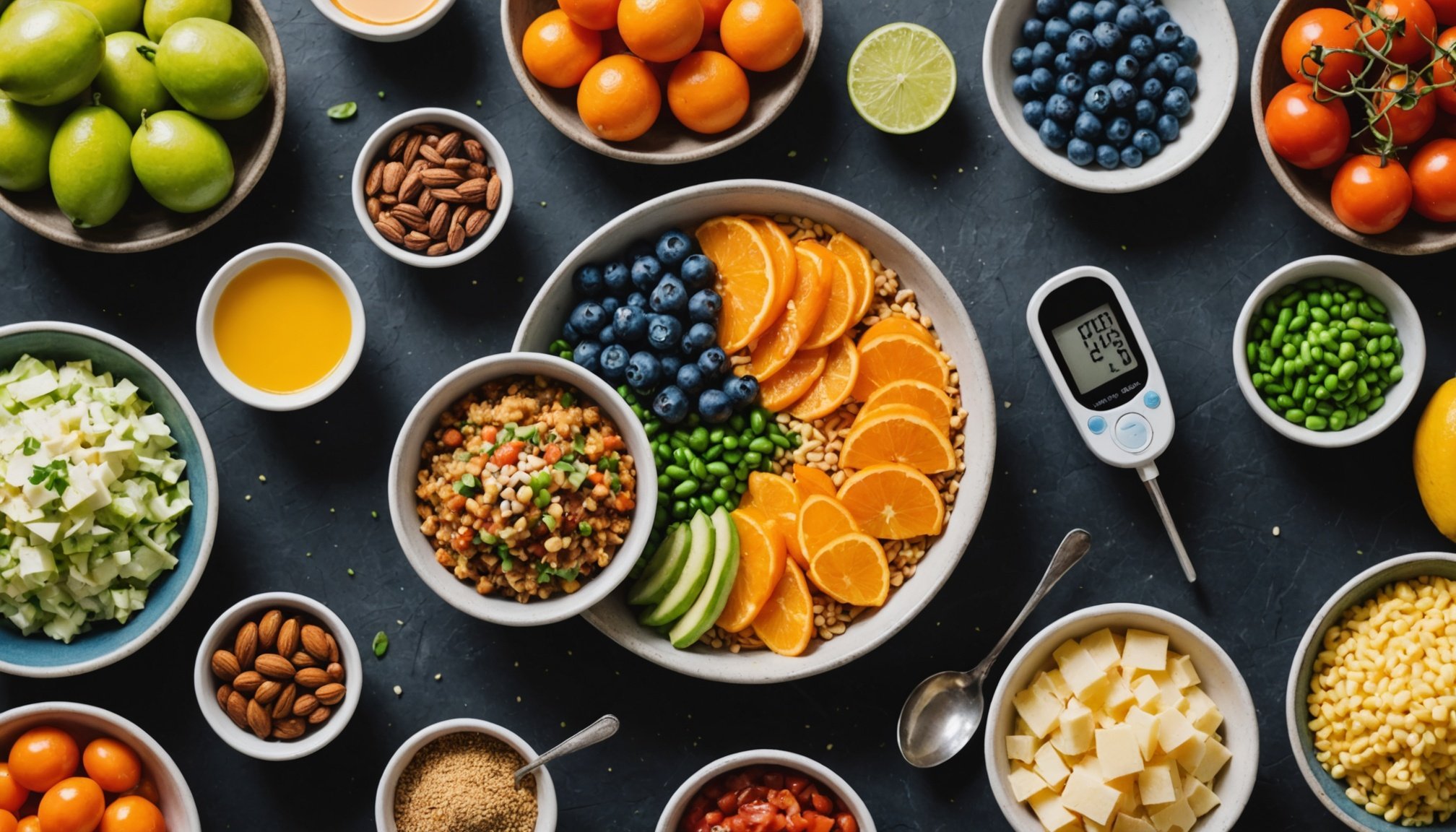Exploring the Effects of Low-Glycemic Index Diets on Managing Gestational Diabetes: A Comprehensive Guide
Managing gestational diabetes mellitus (GDM) is a critical aspect of ensuring a healthy pregnancy for many women. One of the most effective strategies for controlling blood sugar levels during pregnancy is adopting a low-glycemic index (GI) diet. In this article, we will delve into the details of how a low-GI diet can help, the benefits it offers, and practical tips for incorporating these foods into your daily meals.
What is Gestational Diabetes Mellitus (GDM)?
Gestational diabetes mellitus is a condition that develops during pregnancy, typically in the second or third trimester. It is characterized by high blood sugar levels due to the body’s inability to produce enough insulin or to use insulin effectively. This condition can pose significant risks to both the mother and the baby, including complications during delivery and an increased risk of developing type 2 diabetes later in life.
Have you seen this : Exploring the Long-Term Effects of Steroid Use for Asthma Management: What You Need to Know
Understanding the Glycemic Index
The glycemic index is a measure of how quickly foods raise blood glucose levels. Foods are ranked on a scale from 0 to 100, with higher values indicating a more rapid increase in blood sugar. A low-GI diet focuses on foods that have a GI of 55 or less, which are digested and absorbed slowly, leading to a gradual and steady release of glucose into the bloodstream.
Benefits of a Low-Glycemic Index Diet for GDM
Better Blood Sugar Control
One of the primary benefits of a low-GI diet is its ability to help regulate blood sugar levels. Foods with a low GI are broken down more slowly, preventing sudden spikes in glucose levels. This is particularly important for pregnant women with GDM, as it helps manage postprandial hyperglycemia (high blood sugar levels after a meal).
Topic to read : Discover the Cutting-Edge Innovations in Non-Invasive Glucose Monitoring Technology
Weight Management
A low-GI diet can also aid in weight management, which is crucial during pregnancy. These foods tend to keep you feeling full for longer, reducing the chance of overeating and supporting healthy weight gain. This is beneficial not only for the mother but also for the baby, as excessive weight gain can increase the risk of complications during pregnancy.
Heart Health and Reduced Insulin Resistance
Consuming low-GI foods has been linked to a decreased risk of heart disease, which is an important consideration for pregnant women. Additionally, a low-GI diet may reduce insulin resistance, a key factor in the development of type 2 diabetes and other metabolic disorders. This can have long-term health benefits for both the mother and the child.
Foods to Include in a Low-Glycemic Index Diet
Fruits
- Apple: With a GI of around 38, apples are a great choice.
- Grapefruit: Grapefruit has a GI of approximately 25.
- Orange: Oranges have a GI of about 40.
- Pear: Pears have a GI ranging from 35 to 42.
- Strawberries: Strawberries have a very low GI, around 32.
Vegetables
- Broccoli: Broccoli has a GI of around 10.
- Carrot: Carrots have a GI of about 25.
- Cauliflower: Cauliflower has a GI of approximately 10.
- Spinach: Spinach has a very low GI, around 10.
Grains
- Barley: Barley has a GI of around 28.
- Bulgur: Bulgur has a GI of approximately 48, but it is still considered relatively low.
- Steel-cut oats: Steel-cut oats have a GI of about 42.
- Quinoa: Quinoa has a GI of around 35.
Legumes
- Lentils: Lentils have a very low GI, around 29.
- Kidney beans: Kidney beans have a GI of approximately 30.
- Chickpeas: Chickpeas have a GI of around 30.
- Black beans: Black beans have a GI of about 30.
Dairy and Proteins
- Milk: Milk has a GI of around 31.
- Yogurt: Yogurt has a GI ranging from 10 to 20.
- Eggs: Eggs have minimal effect on blood glucose levels and are an excellent protein source.
Practical Tips for Incorporating Low-Glycemic Foods
Choose Whole Grains
Opting for whole grains over refined grains is a simple yet effective way to lower the GI of your meals. Whole-grain bread, brown rice, and oats are better choices than their refined counterparts.
Include More Fruits and Vegetables
Most non-starchy vegetables and fruits have a low GI. Incorporating these into your meals and snacks can help regulate blood sugar levels and provide essential nutrients.
Opt for Legumes
Foods like beans, chickpeas, and lentils have very low GIs and are rich in fiber and protein. They can be added to a variety of dishes, including soups, salads, and main courses.
Incorporate Lean Proteins
Fish, chicken, eggs, and lean meat have minimal effects on blood glucose levels and are excellent sources of protein. These can be included in meals to balance out the carbohydrate intake.
Sample Meal Plan for Gestational Diabetes
Here is a sample meal plan that incorporates low-GI foods:
Breakfast
- Whole-grain cereal with low-fat milk and nuts
- Oatmeal with berries and a sprinkle of chia seeds
- Scrambled eggs with spinach and whole-grain toast
Lunch
- Grilled chicken with roasted vegetables (such as broccoli and carrots) and brown rice
- Lentil soup with whole-grain bread
- Salad with mixed greens, chickpeas, and a light vinaigrette dressing
Dinner
- Grilled fish with quinoa and steamed vegetables (such as cauliflower and spinach)
- Stir-fry with lean meat, mixed vegetables, and brown rice
- Dal (lentil curry) with whole-grain chapati and a side of mixed greens salad
Avoiding High-Glycemic Index Foods and Artificial Sweeteners
High-Glycemic Index Foods
Foods with a high GI, such as white bread, sugary snacks, and refined grains, should be avoided as they can cause rapid spikes in blood sugar levels. Here is a comparison of some high and low GI foods:
| Food | GI Value |
|---|---|
| White Bread | 70-80 |
| Brown Rice | 50-60 |
| Whole Wheat Bread | 30-40 |
| Apple | 38 |
| Banana | 42-52 |
| Oatmeal | 42 |
Artificial Sweeteners
While artificial sweeteners may seem like a good alternative to sugar, their impact on pregnancy is not entirely clear. Some studies suggest that consuming artificial sweeteners can lead to impaired glucose tolerance and weight gain, although the evidence is mixed. For example, a study using Mendelian randomization found no causal link between artificial sweetener intake and gestational diabetes, but it did indicate an increased risk of premature rupture of membranes (PROM) with certain types of artificial sweetener consumption.
Real-Life Examples and Anecdotes
Many women have successfully managed their gestational diabetes through dietary changes. For instance, Sarah, a 35-year-old pregnant woman, was diagnosed with GDM in her second trimester. By switching to whole grains, increasing her intake of fruits and vegetables, and incorporating legumes into her meals, she was able to maintain stable blood glucose levels throughout her pregnancy.
Managing gestational diabetes requires a multifaceted approach, but a low-GI diet is a cornerstone of effective blood sugar control. By understanding the glycemic index, incorporating low-GI foods into your diet, and avoiding high-GI foods and artificial sweeteners, you can significantly improve your health outcomes during pregnancy.
As Dr. Jane Smith, a leading expert in maternal health, notes, “A low-GI diet is not just about managing blood sugar levels; it’s about promoting overall health and well-being for both the mother and the baby. It’s a simple yet powerful tool that can make a significant difference in the quality of care during pregnancy.”
In conclusion, adopting a low-GI diet is a practical and effective way to manage gestational diabetes. With the right foods and a balanced approach, pregnant women can ensure a healthier pregnancy and reduce the risk of complications associated with GDM.
Additional Resources
For those looking to delve deeper into the topic, here are some recommended resources:
- Glycemic Index Chart: A comprehensive chart listing the GI values of various foods can be found on websites like Metropolis India.
- Healthy Indian Diet for Gestational Diabetes: An article by Truemeds provides specific dietary recommendations tailored for Indian cuisine.
- Maternal Dietary Patterns and GDM: A systematic review published in Nutrients discusses the association between maternal dietary patterns and the risk of GDM.
By leveraging these resources and incorporating the tips and advice outlined in this guide, you can better manage gestational diabetes and ensure a healthier pregnancy.











